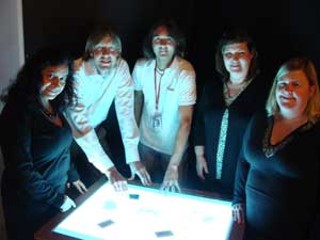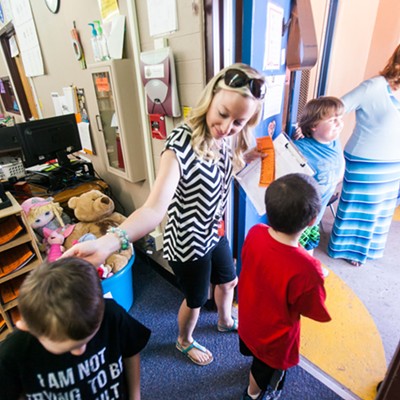Lately, the Science Center has been under a microscope and has been cited as an example of what's wrong with Rio Nuevo spending.
Faust, the Science Center's director, points to the Dec. 7 Arizona Daily Star, and a front-page article regarding the $13 million spent thus far on the design of the Science Center complex. The UA hopes to break ground in the late spring or early summer, along the Santa Cruz River at the base of "A" Mountain.
Faust claims that she welcomes discussion about Rio Nuevo and its projects, but insists that dialogue regarding the Science Center's budget needs to be put in context. For example, yes, the Science Center has spent $13 million on design--over a five- to eight-year period, she says.
However, Faust says she's most disappointed in the morning daily's apparent lack of interest in what the final UA Science Center will resemble.
"In no way did (the recent Star article) take a look at how we are approaching this project now, how we are working hard to build a very different Science Center that is easy to build and cost-effective, before and after it opens," Faust declares.
In June, the Arizona Board of Regents approved the $130 million budget for the merged UA Science Center/Arizona State Museum project, an amount which includes all construction and exhibit costs. Those dollars will come from the city of Tucson through the tax-increment financing revenues of Rio Nuevo.
Faust says that the priority for her team is to work within the $130 million budget, and that with costs in mind, her team took a new approach--one that perhaps no other science center in the country is taking--by using new, but affordable technologies to create exhibits.
Most science centers are filled with themed exhibits built out of wood, particle board, TV screens and other materials, to create visual and hands-on experiences for science center visitors, particularly kids.
However, Faust says that typical exhibit designs and construction can be expensive--and that exhibits break down or get boring after awhile. Therefore, the UA thinks a different approach is in order: Flandrau plans on using open-source hardware and software technologies that can easily be built and fixed in-house. (Open-source software and networks are developed by computer experts who believe in the free sharing of technology and information.)
One cost-saving example that Faust cites: The UA Science Center plans to use dozens of touch-screen tables and interactive walls. Faust says one company the university contacted, GestureTek, makes touch-screen tables similar to the type that the UA wants to use--and charges $50,000 per table.
"Our exhibits director believes that we could produce a comparable table at 55 inches, with multi-touch and object recognition, for approximately $10,000 using our open-source hardware and software," Faust says.
In addition, GestureTek only provides a one-year warranty, and then the Science Center would be on its own. If the center wants to change the content of the GestureTek table, it could be forced pay $5,000 to $35,000 to reprogram it.
"We could change the content in-house for little or nothing," Faust says. "I think this really demonstrates the power of the open-source approach that we are using."
An article in the October issue of Wired magazine offers some clues into the technology to be used at the yet-to-be built UA Science Center. The story is about Arduino, an Italian company that makes circuit boards specifically for open-source networks. Arduino puts of all its schematics, designs and software on its Web site for anyone to download for free. The catch is that plans and software designed from Arduino's materials must be put on the Internet for others to use--which is what the UA Science Center plans to do with its exhibit designs. In fact, Faust says, several exhibit specs have already been discussed and tweaked by posting the plans on open-source networks.
The exhibit floor at the current on-campus Science Center has several prototype tables using the Arduino circuit boards and open-source technology. At one exhibit, a visitor can take an infrared photo of themselves, and at another table, the visitors can e-mail the infrared photo to anybody.
Faust says the goal is to create a center that is interactive and provides an individual experience for each visitor. Kids and adults will learn at their own pace, focus on their own interests and further that experience each time they return--aided by a social-networking software system that saves each visitors' information. The Internet will play a role in the project, too, through those social-networking pages, which will help visitors stay in contact with the Science Center.
Much of this system was developed by a New York-based team hired by the center, with tech engineer Dallan Porter bringing it all together at the UA.
While Faust's team is clearly excited about their plans, inferences that they are misspending public funds have put a cloud over their discussion.
Faust looks at the economic-impact study done by ConsultEcon Inc. in May 2007. (Faust says she likes to point out that it's the same company that ripped apart a proposal to build an aquarium here in the middle of the desert.) ConsultEcon determined a science center would work in Tucson, with the potential to earn almost $7 million each year and bring in more than 105,000 visitors. ConsultEcon also estimates the project has the potential to add more than $70 million annually to the local economy.
"I agree that if we are funded by (sales-tax) money, we should be accountable for how we spend those funds. We've done a good job of leveraging those dollars and will continue to do so," Faust says.














